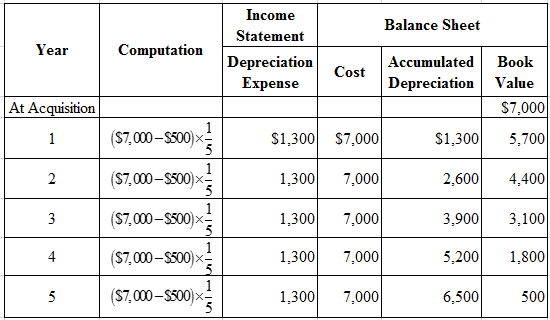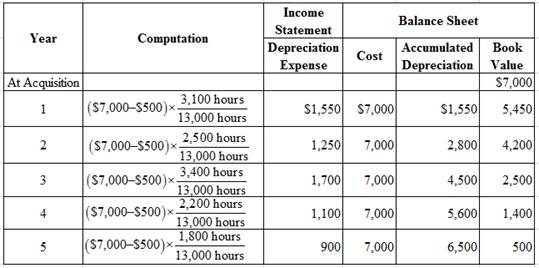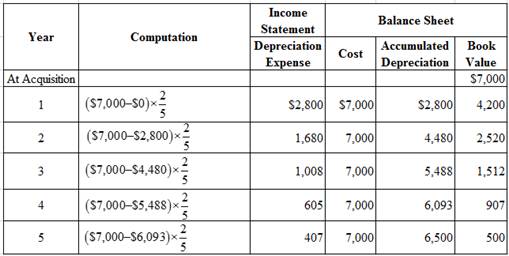
Concept explainers
Accounting for the Use and Disposal of Long-Lived Assets
Nicole’s Getaway Spa (NGS) purchased a hydrotherapy tub system to add to the wellness programs at NGS. The machine was purchased at the beginning of the year at a cost of $7,000. The estimated useful life was five years and the residual value was $500. Assume that the estimated productive life of the machine is 13,000 hours. Expected annual production was year 1, 3,100 hours; year 2, 2,500 hours; year 3, 3,400 hours; year 4, 2,200 hours; and year 5, 1,800 hours.
Required:
- 1. Complete a
depreciation schedule for each of the alternative methods.- a. Straight-line.
- b. Units-of-production.
- c. Double-declining-balance.
- 2. Assume NGS sold the hydrotherapy tub system for $2,100 at the end of year 3. Prepare the
journal entry to account for the disposal of this asset under the three different methods. - 3. The following amounts were
forecast for year 3: Sales Revenues $42,000; Cost of Goods Sold $33,000; Other Operating Expenses $4,000; and Interest Expense $800. Create an income statement for year 3 for each of the different depreciation methods, ending at Income before Income Tax Expense. (Don’t forget to include a loss or gain on disposal for each method.)
(1) (a)
Prepare the depreciation expense schedule under straight-line method
Explanation of Solution
Straight-line method: The depreciation method which assumes that the consumption of economic benefits of long-term asset could be distributed equally throughout the useful life of the asset is referred to as straight-line method.
Formula for straight-line depreciation method:
Depreciation expense: Depreciation expense is a non-cash expense, which is recorded on the income statement reflecting the consumption of economic benefits of long-term asset.
Accumulated depreciation: The total amount of depreciation expense deducted, from the time asset acquired till date, as reported in the account as on a particular date, is referred to as accumulated depreciation.
Formula for accumulated depreciation:
Book value: The amount of acquisition cost of less accumulated depreciation as on a particular date is referred to as book value.
Formula for book value:
Depreciation schedule under straight-line method:

Figure (1)
(1) (b)
Prepare the depreciation expense schedule under units-of-production
Explanation of Solution
Units-of-production method: The depreciation method which assumes that the consumption of economic benefits of long-term asset is based on the production capacity or output is referred to as units-of-production method.
Formula for units-of-production depreciation method:
Depreciation schedule under units-of-production method:

Figure (2)
(1) (c)
Prepare the depreciation expense schedule under double-declining-balance method
Explanation of Solution
Double-declining-balance method: The depreciation method which assumes that the consumption of economic benefits of long-term asset is high in the early years but gradually declines towards the end of its useful life, is referred to as double-declining-balance method.
Formula for double-declining-balance depreciation method:
Depreciation schedule under double-declining-balance method:

Figure (3)
Note:
Compute depreciation expense in Year 5.
(2)
Prepare the journal entries for the sale of equipment under three methods
Explanation of Solution
Journal entry: Journal entry is a set of economic events which can be measured in monetary terms. These are recorded chronologically and systematically.
Debit and credit rules:
- Debit an increase in asset account, increase in expense account, decrease in liability account, and decrease in stockholders’ equity accounts.
- Credit decrease in asset account, increase in revenue account, increase in liability account, and increase in stockholders’ equity accounts.
Prepare journal entry for the sale of building, under straight-line method.
| Date | Account Titles and Explanation | Post Ref. | Debit ($) | Credit ($) | ||
| Cash | 2,100 | |||||
| Accumulated Depreciation | 3,900 | |||||
| Loss on Disposal | 1,000 | |||||
| Equipment | 7,000 | |||||
| (To record sale of equipment) | ||||||
Table (1)
Description:
- Cash is an asset account. Since cash is received, asset account increased, and an increase in asset is debited.
- Accumulated Depreciation–Building is a contra-asset account. Since the building is sold, the accumulated depreciation balance is reversed to reduce the balance in the account; hence, the account is debited.
- Loss on Disposal is an expense account. Since losses and expenses decrease equity, equity value is decreased, and a decrease in equity is debited.
- Building is an asset account. Since building is sold, asset account decreased, and a decrease in asset is credited.
Working Notes:
Determine the gain on sale.
Step 1: Compute book value on the date of sale.
Step 2: Compute gain (loss) on sale.
Prepare journal entry for the sale of building, under units-of-production method.
| Date | Account Titles and Explanation | Post Ref. | Debit ($) | Credit ($) | ||
| Cash | 2,100 | |||||
| Accumulated Depreciation | 4,500 | |||||
| Loss on Disposal | 400 | |||||
| Equipment | 7,000 | |||||
| (To record sale of equipment) | ||||||
Table (2)
Description:
- Cash is an asset account. Since cash is received, asset account increased, and an increase in asset is debited.
- Accumulated Depreciation–Building is a contra-asset account. Since the building is sold, the accumulated depreciation balance is reversed to reduce the balance in the account; hence, the account is debited.
- Loss on Disposal is an expense account. Since losses and expenses decrease equity, equity value is decreased, and a decrease in equity is debited.
- Building is an asset account. Since building is sold, asset account decreased, and a decrease in asset is credited.
Working Notes:
Determine the gain on sale.
Step 1: Compute book value on the date of sale.
Step 2: Compute gain (loss) on sale.
Prepare journal entry for the sale of equipment, under double-declining-balance method.
| Date | Account Titles and Explanation | Post Ref. | Debit ($) | Credit ($) | ||
| Cash | 2,100 | |||||
| Accumulated Depreciation | 5,488 | |||||
| Equipment | 7,000 | |||||
| Gain on Disposal | 588 | |||||
| (To record sale of truck) | ||||||
Table (3)
Description:
- Cash is an asset account. Since cash is received, asset account increased, and an increase in asset is debited.
- Accumulated Depreciation–Equipment is a contra-asset account. Since the equipment is sold, the accumulated depreciation balance is reversed to reduce the balance in the account; hence, the account is debited.
- Equipment is an asset account. Since equipment is sold, asset account decreased, and a decrease in asset is credited.
- Gain on Disposal is a revenue account. Since gains and revenues increase equity, equity value is increased, and an increase in equity is credited.
Working Notes:
Determine the gain on sale.
Step 1: Compute book value on the date of sale.
Step 2: Compute gain (loss) on sale.
(3)
Prepare the income statement of NG Spa for the Year 3, under three depreciation methods
Explanation of Solution
Income statement: The financial statement which reports revenues and expenses from business operations and the result of those operations as net income or net loss for a particular time period is referred to as income statement.
Prepare income statement for NG Spa for the Year 3.
| NG Spa | |||
| Income Statement | |||
| For Year 3 | |||
| Particulars | Straight-Line | Units-of-Production | Double-Declining-Balance |
| Sales revenue | $42,000 | $42,000 | $42,000 |
| Cost of goods sold | 33,000 | 33,000 | 33,000 |
| Gross profit | 9,000 | 9,000 | 9,000 |
| Operating expenses: | |||
| Depreciation expense | $1,300 | $1,700 | $1,008 |
| Other operating expenses | 4,000 | 4,000 | 4,000 |
| Loss (Gain) on disposal | 1,000 | 400 | (588) |
| Total operating expenses | 6,300 | 6,100 | 4,420 |
| Income from operations | 2,700 | 2,900 | 4,580 |
| Interest expense | 800 | 800 | 800 |
| Income before income tax expense | $1,900 | $2,100 | $3,780 |
Table (4)
Want to see more full solutions like this?
Chapter 9 Solutions
FUNDAMENTALS OF FINANCIAL ACCOUNTING
- Principles of Accounting Volume 1AccountingISBN:9781947172685Author:OpenStaxPublisher:OpenStax College
 EBK CONTEMPORARY FINANCIAL MANAGEMENTFinanceISBN:9781337514835Author:MOYERPublisher:CENGAGE LEARNING - CONSIGNMENT
EBK CONTEMPORARY FINANCIAL MANAGEMENTFinanceISBN:9781337514835Author:MOYERPublisher:CENGAGE LEARNING - CONSIGNMENT College Accounting, Chapters 1-27AccountingISBN:9781337794756Author:HEINTZ, James A.Publisher:Cengage Learning,
College Accounting, Chapters 1-27AccountingISBN:9781337794756Author:HEINTZ, James A.Publisher:Cengage Learning,


